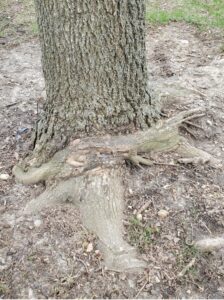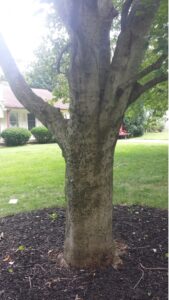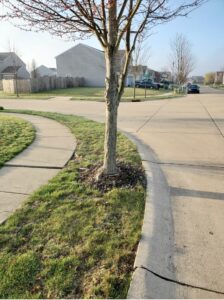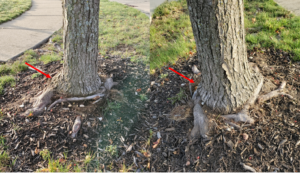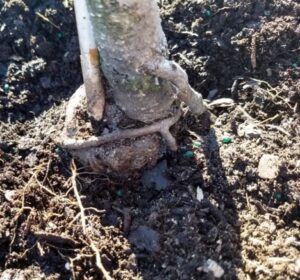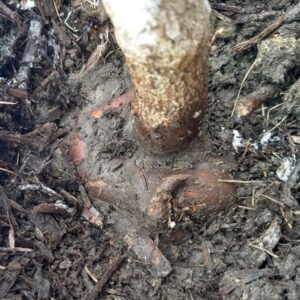Determining the cause of dieback and decline symptoms in landscape trees can be very difficult due to the many cultural, environmental, and biological factors that could be involved. The first place you should look for a culprit when dealing with this type of tree problem is the base of the trunk and the roots. Stem girdling roots (SGR) are one of the most common and preventable causes for long-term tree decline.
An SGR is as it sounds: a root that girdles the stem. This is important because it is the tree unintentionally killing itself as it grows, leading to long-term decline. Root and trunk diameter increase as they grow and if they are in contact with each other, they will create a layer of compression that begins to strangle the tree, disrupting the flow of water and nutrients moving from the roots and carbohydrates moving down from the leaves (Figure 1, 2). The rate of root and trunk growth is not exceptionally fast and the effects of the SGR takes time to become apparent, if it is apparent at all. Some trees to not exhibit the typical decline symptoms, but instead they may begin leaning in the landscape or fail and fall over during heavy winds due to the roots completely girdling the trunk, creating acute compression at one point, and leading to structural instability. These types of situations can cause trees to either have a one-side trunk flare, no trunk flare (especially if the SGR is below the soil line), or have a thickened area at the root-trunk interface (Figure 3, 4, 5).
- Figure 1. A single root girdling to primary roots and part of the trunk of a tree.
- Figure 2. A stem girdling root partially hidden under turfgrass.
- Figure 3. A maple tree that lacks a root flare due to a stem girdling root.
- Figure 4. Swollen base of a tree due to an SGR.
- Figure 5. Multiple stem girdling roots wrapping the base of a tree leading to a large swollen trunk.
SGRs tend to develop due to external factors such as adverse site conditions or improper planting procedure. If the soil is severely compacted or the roots come into contact with an impermeable surface, the roots will grow in a direction in order to get around the impediment. If the roots are unable to grow around the compacted area, it may circle back towards the tree and begin to encircle the tree. These roots may eventually grow into the stem and become SGRs.
How do SGRs develop if your soil is not compacted or the tree isn’t planted in an enclosed space with limited area? Planting a bare-root tree into a hole that is too small for the root system can lead to forcing roots into different directions or even circling the planting hole. If a tree is planted at the correct depth, you can cause SGRs to develop by applying too much mulch (i.e. volcano mulch). The tree can be tricked into thinking that the soil line became higher and put out adventitious roots into this “new soil” and potentially become encircling roots, although this is not always the case.
One of the most common problems that lead to SGRs are pot-bound nursery stock (Figure 6, 7). The longer a plant is grown in a container, the greater the chance there will be roots that hit the side-wall of the pot and begin to grow around the outer edge. If the tree was re-potted with some force, the roots can be pushed into different directions that might lead them SGRs as well. Air pruning containers can get around this issue since the roots stop growing as soon as they come into contact with air and are being used with greater frequency in the industry.
- Figure 6. A newly planted tree with an existing encircling root that will develop into an SGR. Photo Credit: Carrie Tauscher
- Figure 7. An encircling root that was cut at planting to avoid a future SGR. Photo Credit: Carrie Tauscher
Removal of girdling roots, when identified, can remediate the issue if the SGR is not too severe (very large root proportional to age/size of tree OR very deep compression into stem). In many cases the roots that need to be removed are fairly large in diameter still play an important role of providing a conduit for secondary and tertiary roots to move water and nutrients into the body of the tree. If multiple SGRs are present on one tree, it may be necessary to remove the worst affecting root first and allow the other to remain for some time (one or two seasons) to acclimate to the loss of a major root before removing the other root.
Where possible, it is a much easier and less damaging task in preventing SGRs from developing. This means ensuring you have good soil conditions (not compacted), adequate space for the planting hole, and screening your trees either prior to purchase or planting for encircling roots and SGRs. Please see the following link for recommendations concerning tree installation.
https://www.extension.purdue.edu/extmedia/FNR/FNR-433-W.pdf
